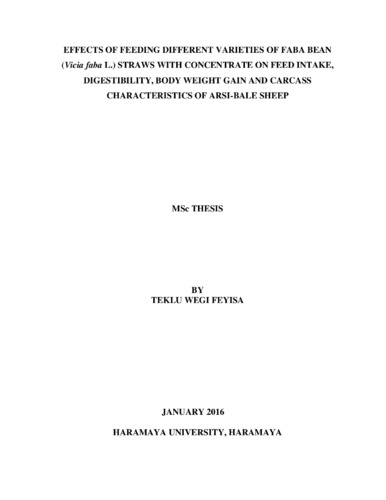Effects of feeding different varieties of faba bean (Vicia faba L.) straws with concentrate on feed intake, digestibility, body weight gain and carcass characteristics of Arsi-Bale sheep
Abstract
A study was conducted using 40 yearling Arsi-Bale sheep with initial body weight of 19.85+0.29 kg (mean + SD). The objectives were to evaluate the varietal differences among faba bean straws and to evaluate effects of feeding different varieties of faba bean straws with concentrate (2 parts wheat bran: 1 part noug seed cake) fed at the rate 70% straws and 30% concentrate mixture on feed intake, digestibility, body weight gain and carcass characteristics of the animals. The varieties included Mosisa (T1), Walki (T2), Degaga (T3), Shallo (T4) and local (T5) which were grown at Sinana Agricultural Research Center. The experiment consisted of 7 days of digestibility trial and 90 days of feeding trial followed by evaluation of carcass parameters at the end of the feeding period. Randomized complete block design was used for the experiment. The experimental animals were grouped into eight blocks of five animals each based on their initial body weight and each animal within each block was randomly assigned to one of the five treatment diets. Yield were significantly different (P<0.001) among varieties evaluated. Crude protein (CP) contents of faba bean straws were 4.9, 5.1, 5.2, 4.3 and 6.2% for Mosisa, Walki, Degaga, Shallo and local respectively and that of wheat bran (WB) and “noug” seed cake (NSC) were 13 and 26.8% respectively. The DM intake of sheep in T2 (754.3 g/day) was higher (P<0.001) than T1, T4 and T5 but did not differ (P>0.001) from T3 (717.9 g/day) and sheep in T3 had higher (P<0.001) DM intake than sheep in T1 and T4. CP intake for T5 was significantly greater (P<0.001) than T3, T1 and T4 whereas no significant difference (P>0.001) from T2. The apparent digestibility of DM of T1, T2 and T3 were greater (P<0.05) than T4 but did not differ (P>0.05) from T5. The OM digestibility was significantly higher (P<0.05) for sheep in T2 than T4. The CP digestibility of sheep in T5 was higher (P<0.001) than that of T3 and T4 but similar (P>0.001) with sheep in T1 and T2 whereas CP digestibility of T1 and T2 were also higher (P<0.001) than T4. Sheep in T2 had greater (P<0.01) average daily gain (64.6 g/day) than sheep in T3 (43.2 g/day), T4 (37.5 g/day) and T5 (48.3 g/day) but no difference (P>0.01) from T1 (52.2 g/day). Feed conversion efficiency was higher (P<0.05) for sheep in T2 as compared to T3, T4 and T5 whereas similar with values obtained for T1. Slaughter body weight and empty body weight were higher (P<0.05) for sheep in T1 and T2 as compared to sheep in T4 but similar (P>0.05) among others. Apart from this, the other carcass components were not affected (P>0.05) by variety of the faba bean straws. It can be concluded that there is significant difference between faba bean straws from different varieties in feed intake, digestibility, body weight gain and feed conversion efficiency and that faba bean straws when supplemented with concentrate had higher potential as animal feed. Based on these results, Walki and Mosisa varieties could be recommended as pulse crop rotation with cereals in the study area.

